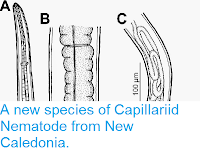Parasitic Nematodes of the genus Strongyloides infect the guts of a wide range of Vertebrate hosts, including Birds, Reptiles, Amphibians, and Mammals, as well as Humans, livestock, and companion animals. Two species are known to infect Humans, Strongyloides fuelleborni, which has two subspecies, one found in tropical Africa and the other in Papua New Guinea, and Strongyloides stercoralis, which has a cosmopolitan distribution, though most infections occur in the tropics and subtropics, and which is also found in Dogs and Chimpanzees.
In a paper published in the journal Scientific Reports on 7 July 2017 a team of scientists led by Eiji Nagayasu of the Division of Parasitology at the University of Miyazaki published the result of a phylogenetic study of Strongyloides stercoralis, using four gene sets plus morphometric analysis. Nematodes were isolated from Humans from Japan, Myanmar, Thailand, Laos, Uganda, the Central African Republic and Tanzania, as well as Dogs from Japan and Myanmar and Chimpanzees from Tanzania, with a view to establishing a phylogenetic tree and potentially determining the origin of infection in Humans.
A Strongyloides stercoralis nematode. Oklahoma State University.
Nagayasu et al. found that the Nematodes could be divided into two main clades (groups with common ancestry), one of which contained all the Human derived worms, plus the Chimpanzee derived worms and all worms from Dog infections in Japan, and some of the worms from Dogs in Myanmar. The second clade was contained entirely worms obtained from Dogs in Myanmar. They interpret this data as indicating that Strongyloides stercoralis infection originated in Dogs and has spread to Humans during the two species’ long association. The first clade has apparently made the jump between Dogs and Humans (and subsequently to Chimpanzees, which are very similar to Humans in immunological terms), while the second clade not made this jump.
Median-joining haplotype network for the mitochondrial Cox1 gene. Each circle represents one haplotype. The size of the circle represents the number of hosts that harbour the given haplotype. The colour inside the circle indicates the host species/geographical origin (country). Numbers beside the branches indicate the number of mutational steps between haplotypes (no number is shown in case of a single-step difference). Branch lengths are roughly proportional to the number of mutational steps. Nagayasu et al. (2017).
Interestingly, a previous study of Strongyloides stercoralis, published in 2014 that looked as a smaller number of gene-sets and which concentrated on infections in Cambodia, had also identified two major clades within the total population of Nematodes, one of which was associated principally with Dogs, but which was also found in some Humans. However, re-examination of this data reveals that all of the Humans infected with the second strain were immunocompromised individuals the HIV from Myanmar; HIV is known for its destruction of the immune system, and often individuals infected with it are infected by organisms which do not usually infect Humans, or even which are not usually pathogenic at all, suggesting that such individuals would be vulnerable to a strain of Nematodes which normally attacks only Dogs.
See also...
Follow Sciency Thoughts on Facebook.








